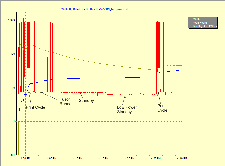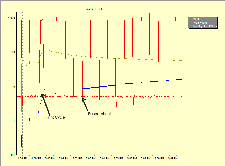- Announcements
- BBQ and Food
- Cars
- Computing
- Cool Stuff
- Current Events
- Electric Vehicles
- Electronics
- Energy
- Flashahaulism
- Funny
- Government
- Hints and Tips
- History
- HVAC
- Induction heating
- Internet
- Lighting
- Misc
- Neon and other lighting
- Nuclear
- Personal
- Pets
- Philosophy
- Photography
- Power Generation
- Product Reviews
- Projects
- Q and A
- RV/Camping
- Science
- Tellico
Categories
Blogroll
 Print This Post
Print This Post
Laser Printers and Inverters
PermaLinkA question came up about whether a laser printer would work with an inverter. I first started running an HP LaserJet II on a pure square wave inverter about 20 years ago. Not a pseudo-sine inverter but a brute-force square wave, produced by a “baseband” (60hz) Tripp-lite inverter. This thing was a simple transformer-based blocking oscillator that ran at 60 hz, more or less.
The LaserJet ran just fine, as did my office’s computers on another inverter. These two inverters and a large bank of batteries and a 250 amp, 14 volt analog power supply from a Univac mainframe constituted my full-time UPS.
Fast-forward to the present. My current laser printer is a Brother HL-5250DN, a sweet little printer that they practically give away. Supplies are fairly inexpensive, far less expensive than HP crap.
I’ve just completed two runs with this printer and a Watts-Up ProES Plus power logger. The first run was using line power to demonstrate the characteristics of the printer. Here is a chart of the printer’s characteristics , taken from the Watts Up.
This shows the characteristic power demand of the printer. The major power consumer is the fuser heater that fuses the toner to the paper. After an initial warm-up, the printer goes into a low power standby mode. The fuser is periodically reheated to keep it at the ready. After so many minutes pass without a print job, the printer goes into a lower power standby mode. The fuser is allowed to cool. After even more time passes, the display leds are extinguished and it goes into a sleep mode.
When awakened by another print job, a few seconds of high power consumption pass while the fuser warms. Then the printer runs the print cycle normally
The second run was via a long extension cord out to my motorhome, connected to the 1500 watt Power-On-Board pseudo-sine inverter that powers the rig. This is the inverter that Sam’s Club sold for a long time, priced at $79 and then $59 dollars. It’s a fine inverter, with good overload ability and auto-fault reset. Here is the chart of the laser printer running on the power from this inverter.
Needless to say, the printer worked just fine. I carry the printer along with me on the road when I travel so this is old news. Even though the supply voltage drops considerably during fuser heating because of the long, light extension cord, the switchmode power supply inside the printer compensates, drawing more amps to supply the necessary watts.
Though I’m not willing to test my theory, I bet that the printer would work just fine on about 170 volts DC. Many other SMPS do.
The raw data, both as output from the Watts Up and in the form of an Excel spreadsheet can be downloaded here.
The program that can open and view the raw data contained in the .txt files can be downloaded here.
Posted by neonjohn on August 4th, 2008 under Cool Stuff, Energy

April 19th, 2013 at 2:13 pm
[…] From http://www.johndearmond.com/2008/08/04/laser-printers-and-inverters/ […]
November 15th, 2014 at 1:38 am
hello, I saw your article and thought you may be able to help me. I’ve been trying for close to a year to get my 1500 watt tiger call pure sine wave inverter to work with my hl 5370 dw brother laser with no success. I’m using 2 gauge stranded heavy duty cables that are made specifically for inverters along with an interstate car battery. The cables are approximately four feet and they’re running straight to my car battery w/ a 200 watt inline fuse. The peak watts on my printer appear to be 675. The alarm goes off when I try and use the printer. Any thoughts?
November 22nd, 2014 at 10:33 pm
Hi Tina,
The fact that your printer will not run with your configuration tells you that something is wrong despite the specs. I think the problem is a combo of your printer pulling large peak watts, your 12 volt wiring being too light and perhaps your battery not having enough surge capacity. Your inverter is likely tripping on 12 volt undervoltage.
I have a Brother HL-5250 laser printer and the equipment to measure the power draw on a cycle by cycle basis. The fuser roller is heated inductively and with a lot of power. When my laser is first turned on, the thing draws a peak of around 1750 watts. The induction heater brings the fuser up to temperature in under 5 seconds – fast enough that a regular breaker won’t trip. Then to maintain temperature it fires for about half a second every 3 minutes or so. The current draw is so high that all the lights in my house flicker when the heater turns on.
Your inverter should handle short peaks like that but it must be fed from a very low impedance source. That means larger and shorter 12 volt cables and perhaps a battery with more surge capacity. Cold Cranking Amps is a good indicator of a battery’s surge capability.
To narrow the problem down, you need a digital volt meter with a min/max peak hold feature. Set it on the 20 volt range, connect the leads to the inverter, activate the min/max feature and then fire off the laser printer. Then see what the voltmeter says was your minimum voltage. It will most likely have dipped below the inverter’s minimum voltage cutoff, typically 10.6 volts.
If that is the case, move the voltmeter to the battery terminals and repeat the test. If the minimum voltage is greater than the inverter’s trip voltage then you must use larger and shorter DC cabling. If the voltage at the battery terminals drops below the threshold then a better battery is required.
If the battery is sagging momentarily but immediately recovering then a large (1-2 Farad) stiffening capacitor of the type the stereo crowd uses might help. It should be connected as close to the inverter terminals as possible. So get the DVM, run the tests and get back with us to report the numbers.
John
January 24th, 2015 at 10:03 am
[…] From http://www.johndearmond.com/2008/08/04/laser-printers-and-inverters/ […]
October 21st, 2021 at 2:59 am
[…] From http://www.johndearmond.com/2008/08/04/laser-printers-and-inverters/ […]